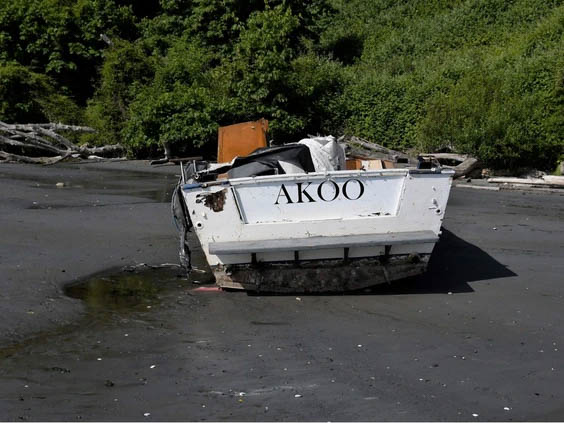The issue of abandoned boats continues to be a scourge across the global boating community. In Canada, the Coast Guard is upping their enforcement.
There is growing pressure worldwide to deal with the issue of abandoned boats.
In places like Venice, Italy, small abandoned boats are such a problem that they’re affecting the region’s aquatic landscape. For Cape Town, South Africa, even luxury superyachts have been abandoned, becoming a longstanding issue for locals.
The problem has reached such a fever pitch that Canada has instituted an Abandoned Boat Program to collect derelict vessels and hold the owners responsible for their removal.
The problem is so widespread, however, that countries like Canada have been forced to level up their enforcement capabilities.
According to the Globe & Mail, there are over 1700 abandoned vessels registered with the Canadian Coast Guard, 70% of which are in the province of British Columbia alone.
Even with the nationwide launch of the Abandoned Boats Program four years ago, the Canadian government had only levied two fines against derelict owners until this year.
In one of those cases, the owner of a wrecked cabin cruiser named Akoo, which washed ashore on Vancouver Island, was fined $15,000 by the Canadian Coast Guard. The fine was levied using the Wrecked, Abandoned or Hazardous Vessels Act — a 2019 law that gives authorities more power to penalize owners whose boats are hazardous to marine environments and public safety.
Paul Barrett, the agency’s superintendent of compliance and enforcement, told The Globe that the Akoo had been anchored in Cadboro Bay in Victoria before breaking loose and washing ashore on a popular beach. The agency contacted the boat’s owner, Ryan Brackenbury, who failed to establish a salvage plan.
“When it first ran aground, it was discharging fuel into the sand,” Barrett told the Vancouver Sun. “There’s smashed glass, there’s people climbing on it. It’s a clearcut case of a hazardous vessel.”
For Brackenbury and the Akoo, it appears there were several months between when it first drifted ashore and the eventual enforcement.
Brackenbury claims he proposed a way of removing the Akoo from the beach to authorities, but the Coast Guard didn’t accept his plan. He also claims he can’t be proven to be the registered owner of the boat.
“It’s not even my boat, like it’s not registered to me. They can’t really prove that it’s mine,” he told The Globe.
In a case like Brackenbury’s, sourcing the boat’s registration and determining the owner are two feats that rarely happen in short order.
“If a vessel’s been left for a really long time, the registries might have lapsed and might not be valid anymore,” Barrett told The Globe.
But while some vessels are difficult to trace, there are several others on the Canadian registry that are well-known and border on public spectacle.
The most notorious Canadian example is probably the McBarge, an abandoned floating McDonald’s restaurant that even has its own Wikipedia page showing the coordinates to its location. The 187-foot barge was built for Expo 86′ in Vancouver and has attracted so much attention it was used for the 2004 Hollywood film Blade: Trinity.
Another unfortunately notorious example is the MV Sun Sea, a Thai cargo ship that was intercepted by the Coast Guard in August 2010. Onboard, authorities found 492 Sri Lankan asylum seekers who all made refugee claims. The incident made international headlines and is believed to have cost Canadian taxpayers some $25 million between the seizure, search, and removal. The vessel was abandoned at the Nanaimo Shipyard shortly thereafter before it was finally dismantled in 2019 when the Public Works and Government Services of Canada got involved.
Nico Preston, a wharf keeper on Mayne Island, between Vancouver Island and the mainland, told The Globe there are many reasons why vessels are abandoned.
“I imagine there are going to be a lot of abandoned boats from kind of the COVID era, where a lot of people got into boating and then had lost interest or became unable to keep up with the costs of keeping a boat on the water,” said Preston. “Then there’s also limited moorage available. It’s difficult to find a place to dock a boat that’s protected. You know, there’s only so many protected harbours in British Columbia.”
So, what’s the solution?
In the case of British Columbia, there’s a growing aspect of locally-operated tracking and enforcement.
John Roe, a longtime mariner in Victoria, BC, started the Dead Boats Society after getting involved with the seizure and disposal of “numerous” problematic vessels over the years.
For Roe and his team, the aim of Dead Boats Society is to promote “research, education, inventory, removal, assessment, remediation, and disposal of dead boats and marine debris.” The not-for-profit organization has undertaken over 10 restoration projects around greater Vancouver Island focusing on particularly troublesome bays, islands, and harbours.
All proceeds they raise go towards cleaning up their beloved waterway.
He told The Globe that many boats end up abandoned due to “urban pressures,” with marina space in short supply.
“The prices have gone up exponentially. I can’t afford to keep a boat in the marina myself, so none of my boats are in the water right now,” he said. “There’s no economical way to dispose of these things. There just isn’t.”
But while the abandoned boat problem isn’t likely to decrease under current economic conditions in the near term, Roe and his team will continue to make a difference. So will the Coast Guard.
“We can govern what happens, both municipally and provincially, and federally what happens in our water,” Roe said. “So, we just need to say, ‘your rotten old boat’s got to go.’”
For Barrett and the Coast Guard, “We’re less worried about eyesores. What we’re worried about with this act in particular is hazards,” he said.







